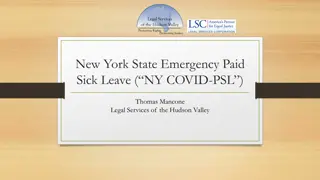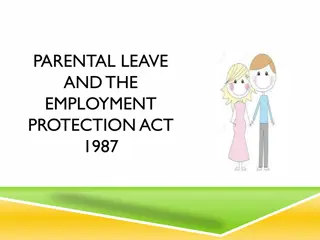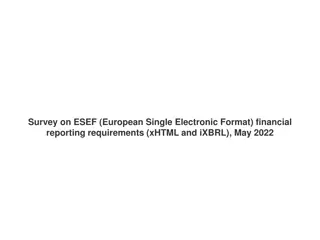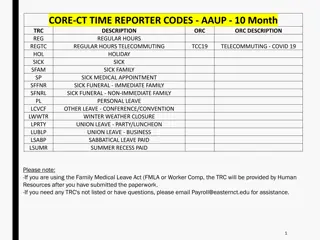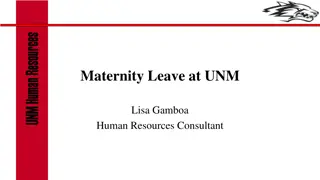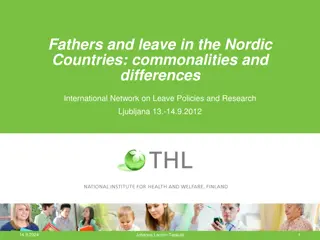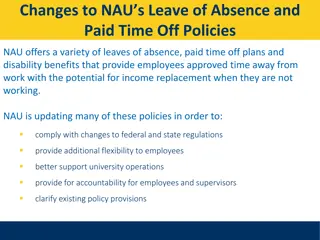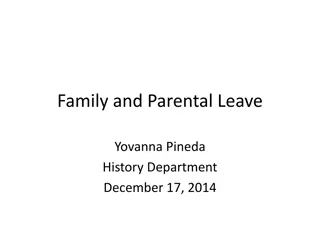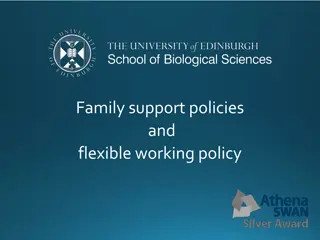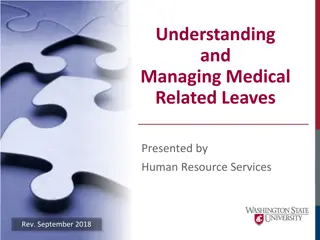
Politics of Parental Leave Policies in Finland: Challenges and Reforms
Explore the intricate politics surrounding parental leave policies in Finland, focusing on the challenges faced, reform efforts, and the impact on gender equality. Discover the elements of the Finnish family leave system, obstacles to reform, and a case study on a failed reform attempt from a gender equality perspective.
Uploaded on | 1 Views
Download Presentation

Please find below an Image/Link to download the presentation.
The content on the website is provided AS IS for your information and personal use only. It may not be sold, licensed, or shared on other websites without obtaining consent from the author. If you encounter any issues during the download, it is possible that the publisher has removed the file from their server.
You are allowed to download the files provided on this website for personal or commercial use, subject to the condition that they are used lawfully. All files are the property of their respective owners.
The content on the website is provided AS IS for your information and personal use only. It may not be sold, licensed, or shared on other websites without obtaining consent from the author.
E N D
Presentation Transcript
The politics of parental leave policies in Finland Anna Elom ki, Gender Studies, Faculty of Social Science Tampere University, Finland
The starting point of the family leave reform must be reconciliation of work and family and wellbeing of children and families (Finnish Confederation of Professionals, STTK) It is important for us that the family can choose itself which parent stays at home (The Finns/Blue Reform) The family leave reform can at best increase our employment rate significantly (Central Organization of Finnish Trade Unions) Our starting points are the needs and hopes for families without money one cannot make a better reform for families (Centtre Party) Our family leave model creates a significant incentive to return quickle to work in this economic situation, the reform has to be done in a cost-neutral way (National Coalition Party) Lenghening the total amount of leave is not a path to success. Increasing costs prevents job creation (Confederation of Finnish Industries, EK)
Finnish family leave system Elements of the leave system Maternity leave (approx. 4 months earnings-related) Paternity leave (approx. 2 months, earnings-related) Parental leave (approx. 6 months, earn.-rel., to be shared, no quota) Home care allowance (low flat rate, until child is three) Some problems: Men s low take up of family leave + women s long absences from the labour market and impacts on salaries, pensions etc. Importance of class, education, migrant background etc. for leave use Reform on the agenda of Finnish gender equality policy and women s movements for a long time (goal for many: so-called 6+6+6 model)
Obstacles to family leave reform Conflicts between political parties related to home care allowance: Centre Party, the Finns party and families freedom to choose Left and value-liberal parties have been more positive towards increasing leave earmarked to fathers than conservative parties Conflicts about money: cuts vs. increases in benefits Power of labour market organisations: corporatism + leaves funded mainly through employer and employee contributions Decisions about family leave in bi-partite and tri-partite working groups Vested interests of labour marker organizations visible in outcomes In the early 2000s, opposition to lengthening fathers leaves, but views have changed in the 2010s
Case: Failed family leave reform (20152018) Based on reseach with Armi Mustosm ki and Paula Koskinen Sandberg, from gender equality perspective (Elom ki et al. 2020; 2021) Research material: interviews with central actors (n=14), document archive (n=101) Methods: descriptive tracing of policy process and discursive approach structured across three stages of policy process Agenda setting phase (Spring 2015-August 2017) Negotiation phase (September 2017-February 2018) Failure of the reform process (February 2018) Unfavourable moment: from redistribution and social investment to austerity paradigm (Nyg rd et al. 2019) + conservative government
Protagonists of the reform Centre Party (Prime Minister): rural conservatism, economic centre National Coalition Party: economic conservatism, value liberalism/conservatism The Finns Party/Blue Reform: nationalism, populism, value-conservatism Central Organization of Finnish Trade Unions (SAK): vocational education Finnish Confederation of Professionals (STTK): tertiary education Confederation of Unions for Professional and Managerial Staff in Finland (Akava): higher ed. Confederation of Finnish Industries (EK): private employers and business orgs. Local government employers (KT) Government administration: preparing proposals and impact assessment
Agenda-setting phase: struggles over framing Reform not originally on the government s (2015 2019) programme social partners proactive in raising it on the agenda from 2016 onwards
Agenda-setting phase: struggles over framing Four contradicting frames: costs, employment, gender equality, family Idea of cost neutral or at least low-cost reform gains ground: SAK first to talk about cost-neutrality, other actors (e.g. Coalition Party) follow Reform mainly framed as a means to increase employment rate (EK, Coalition Party, Akava), challenged by Centre Party, the Finns Gender equality present, but not the main goal for most actors; constructed as labour market equality, differences between women and families disappeared Equality between families (e.g. same-sex couples), families and children s well-being, families freedom to choose
Reform process begins with strict political framework conditions Positive employment effects verified by the Ministry of Finance. Allowances must be reformed within government s mid-term fiscal framework Improved gender equality in working life and in parenting Increased participation of children in early childhood education Simplify the insurance scheme Preserve the right to take care of children at home until the age of 3 years. Prime Minister s Office, 31.8.2017
Negotiation phase Tri-partite group Trade Unions (SAK, STTK, Akava) Employer orgs (EK, KT, SY) Ministry of Finance (impact assessments) Social insurance institute of Finland (KELA) Civil servants from different ministries Minister group" Centre Party + Advisor Coalition Party + Advisor Blue Reform + Advisor Ministry of Social Affairs and Health Unilateral talks/ lobbying Bi-partite negotiations
Negotiation phase Difficult negotiations between government parties and in the tri-partite working group conflicts implicit in agenda-setting phase became visible Strong political leadership reduced the role of tri-partite negotiations and the power of social partners ( negotiating with tied hands ) Limiting economic framework conditions: Increasing fathers quota required reducing leave available for mothers and shortening home care allowance Cut-reform difficult for trade unions and Centre Party, but in the interests of National Coalition Party and EK, who dominated the negotiations Only Centre Party and the Blue Reform (previous Finns) defended home-care alliance
Stalling of the reform At the final stage focus on 4+5+4 model extension of fathers quota, shortening of divisible leave, shortened home-care allowance Employment impact 1300 persons, costs 90 million, 2/3 families would have lost financially Centre Party unilaterally halted the reform the underdog used veto-power? Centre Party: We cannot accept a cut of several hundred euros for families National Coalition Party: The reform fell because the conservative wing of Centre Party did not accept cuts to home care allowance Would labour market parties have reached a bi-partite compromise had the Centre Party not stalled the process? Did EK s unwillingness to increase insurance contributions prevent a political compromise?
Politics of knowledge-production Struggles over policy-relevant knowledge in all stages, role of economic, quantitative knowledge Agenda setting-phase: qualitative research by THL that challenged the employment-focus rebutted by economists close to government and LMOs Negotiation phase: Priority given to economic expertise in policy-making (actors + knowledge): subsumed gender and wellbeing goals to economic goals; served certain interests; sidelined gendered power relations Stalling of the reform: Knowledge about distributive impacts repoliticized questions about class and redistribution; different interpretations of evidence
Conclusions for politics of parental leave policies In the context of austerity, family leave reform only able to enter the agenda as a cost-neutral labour market / workfare reform Framing matter: concrete outcomes for policy content (e.g. exclusion of specific goals and measures) Goals related to gender equality and well-being of children and families easily sidelined in ideological and interest-based battles between political parties and labour market organisations Shift in corporatist power dynamics: When labour market organisations pushed into a more consultative role in family leave reform, political ideologies of government parties in more decisive role Knowledge and expertise matter: Priority given to quantitative, economized knowledge helped to sideline gender and wellbeing goals and served the interests of economic hardliners


